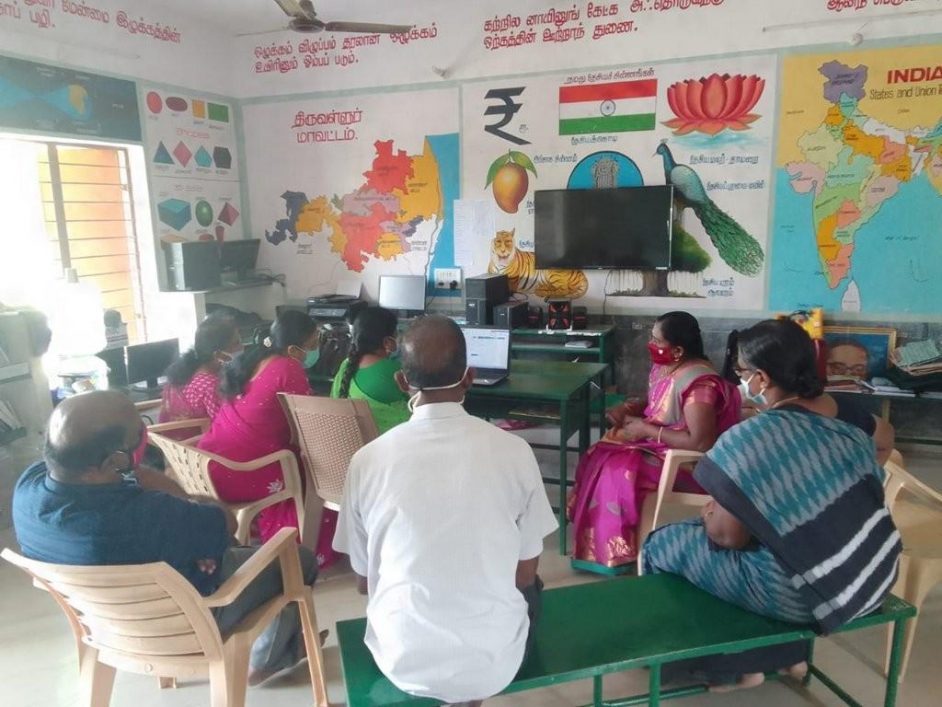With support from IITM Pravartak Asha Kanini has been enhance in many ways and taken to all the government schools in Thiruvallur. Here is an annual report that covers the work done in the project from April 2021 to March 2022.
Asha Kanini project of Pravartak has been launched in April 2021 with funding from John Crane. While efforts for this were already underway internally in Asha, the project by Pravartak enables it to be scaled up to support all of Tamilnadu’s government schools.
While there are some photos in this report, you can see more photos of the project in action here.
Background
State of Technology Aided Learning
While technology aided learning has been a stated goal for several years, not much has been accomplished in this regard. There have been several reasons for the failure.
- Early approaches with CAL centres (Computer Aided Learning centres) setup of various schools all over Tamilnadu by SSA gave good quality contents but these contents were not mapped to the TN curriculum. The Diksha contents provided now are aligned to the curriculum and are easily accessible.
- Teachers were not comfortable using computers. Training was often organised at block or cluster level centres and not at the schools with the environment they would have to deal with every day. As a result, most of the teachers (even those who received the training) were uncomfortable to use the computers to teach the children.
- There was no organised arrangement to regularly service these computers. Most of the computers in the rural schools would be lying in a permanent state of disrepair.
- People viewed computer aided learning as showing videos to children. Other / better ways of using computers for education were ignored. Diksha also suffered from this same problem. Most of the contents were just videos. Really good active contents are available like NLVM, PhET, Geogebra etc and there were several resources for teachers to conduct experiments and rich activities in the classes. Contents such as these were not emphasised or even provided with Diksha.
- In rural India the internet connection is still quite poor. The computers given by the govt often did not have a Wifi dongle and did not have any to connect to the net. This made Diksha difficult to use as it required permanent connection to the Internet.
- There was little or no data collection from the usage of these technology contents for education to help improve the kind of contents and its delivery.
Asha Chennai developed Asha Kanini with these issues in mind. See our website to understand more about Asha Kanini. Asha in been using this in 100+ primary and middle schools in Tamilnadu and another 6 schools in UP that we support. These were mostly used by Asha teachers who were working in these schools. Some of the government teachers in these schools were also using Asha Kanini and its contents.
Project Goals
Asha and IITM Pravartak came together to take Asha Kanini to all the government schools in Thiruvallur District as a pilot for wider deployment. The goals of the project were,
- Continue the development of the Asha Kanini app for windows and the server backend with specific focus on scalability and easy user experience.
- Develop a new Android version of Asha Kanini app.
- Continue developing the contents, esp the lesson plans to meet the requirements of children and teachers at different skill levels.
- Take Asha Kanini to all the primary and middle schools (govt and govt aided) in Thiruvallur District, install it on the school computers and train the teachers on how to use it.
- Do some rudimentary maintenance on the computers in the schools so that any computer that can be used is usable and is used.
- Collect and present usage data to understand how Asha Kanini and more broadly technology is being used.
A Late Start
Due to Covid-19 pandemic, schools closed in March 2020. When the project was proposed, we were expecting the schools to reopen at least by the usual start of the academic year in early June 2021. However, the schools remained closed till Nov 2021. We couldn’t start our main work of training teachers in the schools till that date. The software and content development work proceeded but we didn’t add the trainers to the project until Oct 1st. Even then only a couple of trainers were added then. Most of the trainers were added by Nov 1st.
Project Implementation
The following sections talk about the various aspects of the project’s implementation during the year 2021-22.
Software Development
We had two software engineers on the project from April 2021. They resigned by Nov 2021 and we have started another experienced engineer assisted by an intern from Feb 2022.
The Windows version of Asha Kanini has been available for many years. Several new features were added which included the following.
- Software upgrade – Earlier this was required to be done manually by download from the website. Now, when a new version of the software is available, it prompts the user and upgrades from within the software itself.
- Bookmarking favourite contents.
- Integrated search/browse view – Previous version had separate views which made it impossible to search for phrases within say a class-term-subject selection.
- An improved usage data with display of Views and Likes information for each content.
- Code-signing of the Windows installer. Code signed installers will not generate a warning that the user is installing an executable from an unknown source.
- Enhancements in registration and login.
- Enhancement to the lesson plans display to also be able to meet the requirements of the Maths, English, Science and Computer Science lesson plans.
An early Android version was available for installation by about September. This was made available through the Google Play Store by the November time-frame. This supported the following features.
- Integrated Search and browse contents including QR scanning.
- Bookmark contents.
- Support most of the existing mapped contents for windows. In particular, our own lesson plans should be supported completely.
- Package and content download with caching. Cached configuration files as well as limiting the size of the downloaded contents.
- Network independence.
- Registration and Login.
- Uploading usage data to the server and display of views and likes.
Here are the photos we put up in Google playstore for our Android app.
Several server side featues were also incorporated during this time.
- A broad redesign of the static contents of our kanini.ashanet.org website. This will also not include information about all the additional packages that we have mapped.
- UI for managing packages.
- Display of Usage data by contents and by geography.
Content Development
Content development was done on several fronts. The contents development in terms of the mapping of packages has been going on since 2014. We continue mapping new packages as well as improving the mapping. We have added additional details to make the contents more easily searchable. We have provided thumbnails for all the contents etc. We made the packages ready for Android.
Besides providing mapped contents we have also been creating lesson plans for Maths, English and Science. The idea is to not replicate the good lesson plans already created by the SCERT for the Tamilnadu textbooks. We are providing the following things as part of our lesson plans,
- A curated collection of the best digital resources to use with a lesson. These contents are also given the context required to effectively use them. i.e. Are they intended for teaching in the classroom or for use by students directly or for providing resources for teachers to prepare for teaching a lesson? Further are these for weaker children or for stronger children etc. We envision the lesson plan as the primary interface a teacher will use to access contents required to teach a lesson.
- Provide worksheets aligned to the lesson – both digital worksheets to be solved on the computer and printable worksheets to distribute to children.
- Provide classroom activities aligned to the lesson to enhance conceptual learning. Provide a video of the activity being performed by a class and a list of easily accessible resources required to perform the activity.
The lesson plans have been significantly enhanced during the course of this year. Here are the details of all the content work that has been done from April 2021 onwards.
Package Mapping
- Several new packages were mapped – Code.org, Math Playground, Hooda Math, Math Learning Center, Blockly Games and several useful websites were also identified and analyzed by the teachers for mapping into packages.
- Introduced Search Tags to mapping files to make content easy to search and access through the Asha Kanini App
- Introduced Title and Description for content in regional languages Tamil and Hindi apart from English.
- Many packages were made available in online as well as offline mode, like Easy Teaching, Games to Learn English, Blockly Games and Diksha so that they can be accessed without the internet.
- New content types like Books, Games, Worksheets and Interactive tools for learning concepts have been mapped and made available for Lesson Plans as well.
- Flash content which is no longer supported by browsers has been phased out.
- Several packages have also been expanded to include content suitable for teaching middle school levels – 6th to 8th grade. For eg: Geogebra
- Packages have been updated to the latest curriculum issued by the State Governments especially for the 8th grade.
- Several Worksheets, Games and Content created by Asha teachers for the mini – schools have been made available as packages as well.
Maths Lesson Plans
- Created motivating story videos for lesson plans.
- Created lesson plan for Term 3 classes 2, 3 & 4 for all lessons.
- Added more classroom activities by topics.
- HTML links checked and did corrections for links that are not working.
- Merged the maths lesson plans, with the Ramanujam museum package (worksheets), and added teacher created worksheets.
- Art and craft related contents for Maths lesson are added to Asha Kanini.
English Lesson Plans
- Activities in pdf format are given separately for each lesson plan.
- Activity videos are prepared.
- We gave offline links to Diksha contents.
- New contents are added for all classes, all terms lesson plans.
- Three level worksheets are being added to the lesson plans.
- Description for all the contents in lesson plans.
- Usage of kits videos are also in the process.
Science Lesson Plans
- Added pre test and post test for Term 1, Term 2 and Term 3. Prepared worksheets for all the classes. Working on adding 3 levels of worksheets for each lesson.
- Added new content work (Activities for class 3 to class 5) for Term 1
- Added videos for some lessons.
- Translated all the activities into Tamil.
- Prepared lesson plan forTerms 1 and 2, Class 1 and 2 and included it in lesson plan and finished html work for Term 1.
- Another organisation Krvidya created activities and worksheets specifically for inclusion in Asha Kanini. We have added these to the lesson plan. We also translated and made this available in Tamil.
- Added new content to Term 2 (activities and worksheets) and also did tamil version for it from Class 1 to class 4.
- Finished description for Term 1 lesson plans and it is in the process.
Training the Trainers
As the role of a trainer required training government teachers, it required teachers with some seniority. As each trainer is allocated all the school in an entire block, this also required a lot of travel for the teachers. Further our ability to monitor the trainers was also limited as they would mostly be travelling to schools we have no prior history with. Given these constraints, we preferred to give our existing senior teachers an incentive and switch them to the role of a trainer. We hired two trainers from outside as well.
The external hires were made to overlap with current computer teachers and learnt Asha Kanini in October. Because of the rains, many of the days in November were also holidays for the schools. We used these days for training the trainers.
Training them on Asha Kanini
These external trainers (and a couple of the internal trainers too) needed to be trained on all the features of Asha Kanini. The trainers were made to overlap with existing experienced computer teachers to see how they can We had to develop some materials for presenting Asha Kanini. The trainers practiced these and became comfortable talking about the rationale behind Asha Kanini and how it can help address the pain points the school teachers have with the existing Diksha. These training session were organised at Thiruvallur.
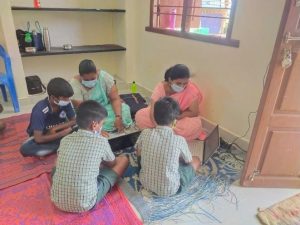
Software Installations
While one can download and install Asha Kanini from our download page, this will only install the software with minimal contents. Rest of the contents will be downloaded when they are used the first time which will require good network. The total contents (which is continuing to grow) is at about 120 GB! As poor network is one of the main problems in these rural school, we equipped our trainers with pendrives and external disks so that they can carry with them all the contents required for the school computers. The teachers also encounter a variety of installations like Windows 7 or 10, 32-bit machine or 64-bit machine etc. They needed to carry with them the software for all these combinations. We had to train the trainers on how to recognise the machine/OS type, check the space available on the hard-disk and install software and contents appropriately.
They will also install some additional software like Java SDK, TuxPaint, VLC media player etc. which are required for good use of the contents that come with Asha Kanini. Very often the machine will be virus ridden or the OS will be corrupt in some other way. They teachers were also trained to recognise these and reinstall the OS and other things on the computers as required. These training sessions were conducted mostly by Muthu, our hardware/systems engineer.
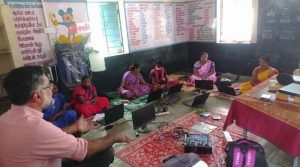
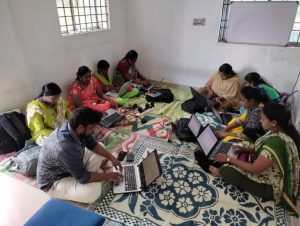
Hardware Maintenance
Often the machines in the schools will not even boot up. Some basic maintenance can often clear up the problem. Connecting the cables properly, cleaning up the dust settled on the computers, cleaning the memory and other connectors etc. will clear a large percent of the project. Muthu also trained the trainers on performing basic hardware maintenance on the computers. If there are bigger problems, they will coordinate with Muthu to have them fixed.
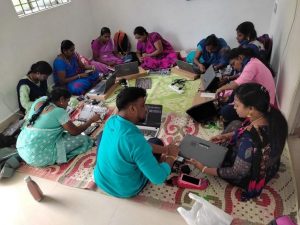

Observation Visits
One of our content leads, Nathiya was also tasked with monitoring the training programme. Once a week, she went on observations visits to the schools and worked alongside a different trainer every week. She could observe the common problem encountered by the trainers and help shape our programme. She could also provide feedback on the work done by the trainers and help improve that.
Trainers’ Work
With the schools opening on Nov 1st, the trainers started going to schools on the working days. Further with the CEO granting us permission to do this work formally on Dec 27th, in January our teachers could also go to block level and cluster level training sessions and get a slot for talking about Asha Kanini. Here is the letter from the CEO.
Training the Teachers at School
Asha Kanini Trainers initially talk to the school HMs either by phone or during a scouting trip and go to the school at a convenient time. They gather details about the schools like number of teachers, number of students, number of computers of which how many are working etc. Because of our presence in several of the blocks in Thiruvallur, many of the school HMs may already know a little bit about Asha. Our trainers will explain to them about Asha, Pravartak and Asha Kanini. They will get the teachers to talk about how they have used Diksha or the computers in any other ways towards teaching. They will explain how Asha Kanini will make it very easy for them to use the contents relevant for the lessons.
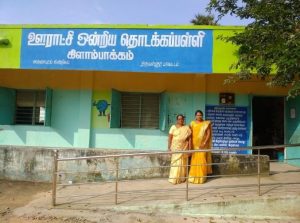
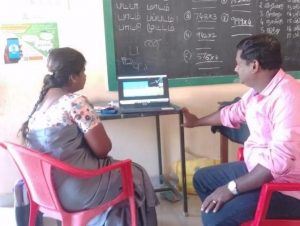
They may also take a couple of sample classes with a mix of younger and older class children to show how the children enjoy learning with the computers. This will also help demonstrate some of the very different kind of contents that we have with Asha Kanini than what the teachers typically use with Diksha.
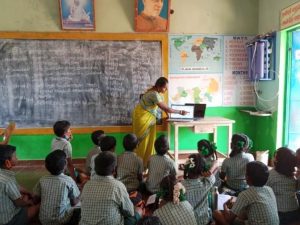
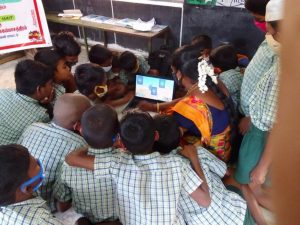
Computer Maintenance and Installations
The teachers than spend time with the computers in the school. They will perform rudimentary hardware maintenance, they may have to reinstall the OS etc. Once the system is ready, they will install Asha Kanini and its contents and also third party software that our contents require. Note that the number of computers available with the school with vary widely. There are still many school with no computers. Our teachers may not even visit these schools as it doesn’t serve any purpose. Some bigger middle schools may even have 5+ computers. Typically our teachers would need to spend a whole day in such schools.
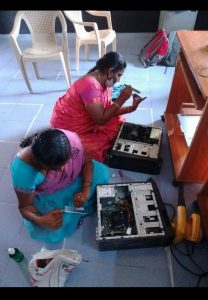


With the availability of the Android version of Asha Kanini, our teachers also install Asha Kanini on the Android phones of the teachers and demonstrate that also.
Training During Teacher Meetings
As the schools closed once again in January because of the Omicron wave, the education department did not give leave for the teachers. Instead several block=level training sessions were held. Our teachers talked to the Block Education Officers of the respective blocks and got a couple of hours during these training sessions to talk to the teachers. The format for this was different in different blocks. In some blocks, teachers from all the schools were brought to one centre (typically a higher secondary school) where the training sessions were held from groups of teachers in different classes. 50% of the teachers came for one week for a series of training sessions and the other 50% will be at their schools. The next week the remaining 50% would come. In other blocks the training were held at cluster level with the teachers coming in smaller numbers at different cluster centres.
Our trainers went to these training session and introduced the teachers there to Asha / IITM Pravartak and the Asha Kanini software and contents. Rajaram also visited some of these training sessions.
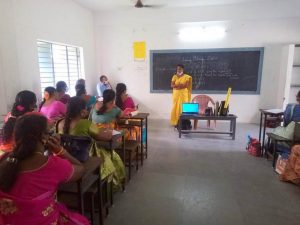
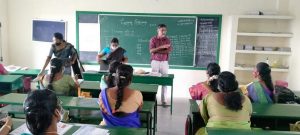
During these trainings, they could collect the details for all the schools in one shot. They fixed appointments with a bunch of school HMs to visit the schools in the subsequent weeks. During this time, they also helped the teachers install the Android Asha Kanini on their phones. This speeded up our process of spreading Asha Kanini to all the schools.


Follow up Visits to Schools
After training to the teachers and installing Asha Kanini on the computers at the schools during the initial couple of visits, the teachers will continue to have follow up visits to the schools. This may be to update the version of the software and contents. This may also be in response to specific request from the school because they had some doubts regarding some features. Or it may well be just a visit to see how the schools is progressing in terms of using Asha Kanini. Given that the teachers are yet to visit all their schools even once, follow-up visits have not started in a large way. But these will pick up pace in the coming months.
Financial Update
The following table gives the budgeted amount as well as the projected expenses till March 31st 2022 (incl actuals till Jan 2022).
| S No | Description | Number | Cost per month per person | Yearly Budget | Actual Expenses | Work Status | |||
|---|---|---|---|---|---|---|---|---|---|
1 | Asha Kanini Developers (loaded cost) | 2 | 35,000 | 8,40,000 | 524197 | The salaries were a little lower and the workstation rent was paid in a different project. New laptops were not required. There was also a gap of 2 month when existing developers resigned and new ones brought in. | |||
2 | Asha Kanini Data Analyst (loaded cost) | 1 | 35,000 | 4,20,000 | This position was not filled. This work was done by volunteers. | ||||
3 | Lead teachers – Train the trainers, map content and develop new content incl lesson plans (loaded cost) | 2 | 17,500 | 4,20,000 | 465774 | Hired and doing the required work. Cost was a little higher because one of them took the additional responsibility of lead trainer. | |||
4 | Lead Trainer and Project Coordinator (loaded cost) | 1 | 32,000 | 3,84,000 | 375917 | One coordinator for the project. | |||
5 | Trainers (loaded cost) | 8 | 20,000 | 19,20,000 | 841204 | Project started only by Sept 2021. We hired only 7 trainers to cover 11 blocks of Thiruvallur. 3 more blocks not covered. | |||
6 | Hardware Engineer & Network administrator for managing the network and devices (loaded cost) | 1 | 35,000 | 4,20,000 | 356109 | One hardware engineer hired and working for the project. | |||
7 | Repair costs for devices | 2500 | 1,00,000 | 30000 | We will be replacing some faulty keyboard, mouse, cables and such things shortly. | ||||
8 | New Devices and Data plan for all devices | 0 | 0 | ||||||
9 | DVD, brochure, writing pad, etc. to be distributed during training at each cluster. | 40 clusters | Rs 2500 per cluster | 100,000 | 10000 | We had some old brochures which we were using. We have to print some now. We didnt required DVDs as we mostly used pendrives / external disks. | |||
10 | Teachers training expenses — travel, conveyance and food during trips to Chennai and conveyance and refreshments/food during teacher meetings Rs 300 per person per month. | 13 | 300 | 47,000 (rounded to 1000) | This was accomodated in Asha’s other projects. | ||||
11 | Miscellaneous (Emergencies/Services) | 30,000 | This was not required. | ||||||
12 | Server Costs | Did not Budget | 40588 | We are hosting our Kanini website through AWS (kanini.ashanet.org). We will also be topping up the payment to 2Factor for SMSes. | |||||
| TOTAL | 46,81,000 | 2,643,789 | |||||||
Total funding received for the project: Rs 42,12,274/-
Pravartak/IITM Overheads: Rs 2,09,495/-
Spent by March 31st 2022: Rs 26,43,789/-
Balance available for 2022-23: Rs 13,58,990/-

